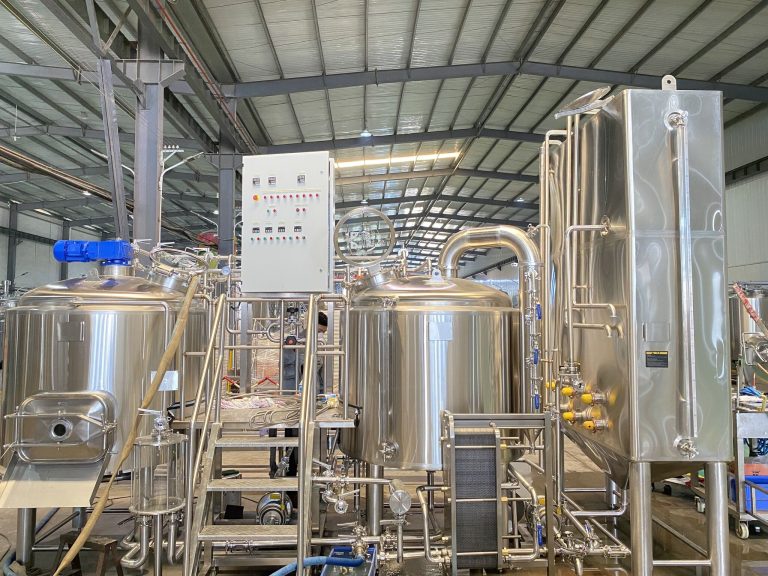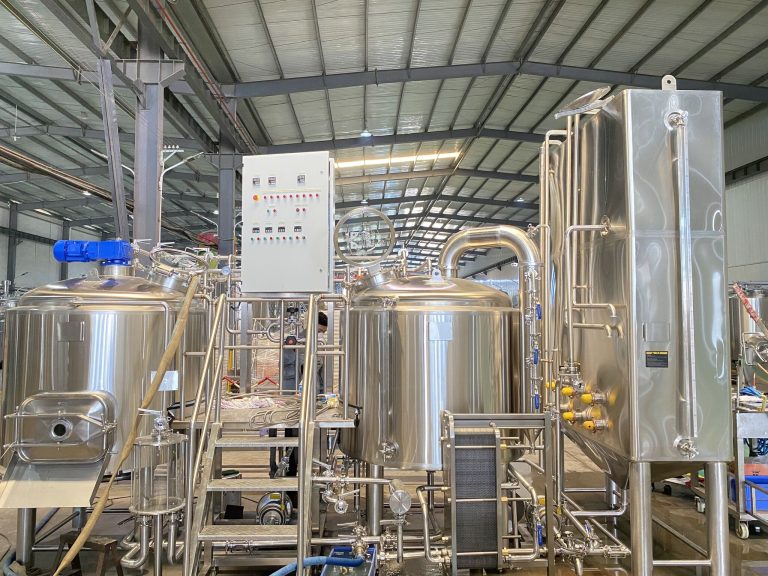

A 200-liter nano brewing setup represents a fantastic intermediate step between small-scale homebrewing and larger commercial brewing operations. This size allows for increased production capacity while maintaining the flexibility and creative freedom that smaller setups offer.
A 200-liter nano brewing setup represents a fantastic intermediate step between small-scale homebrewing and larger commercial brewing operations. This size allows for increased production capacity while maintaining the flexibility and creative freedom that smaller setups offer.
2.2HL NanoBrewery System Specification:
| Output/Brew | 200L |
| Brew/Week | 2~6 |
| Output/Week | 4~12HL |
| Electric Supply | 3phase/380(208, 415,480…)v/50 (60)Hz Single Phase/ 220(110, 240…)v/50(60)Hz |
| Heating Source | Electric/Steam |
| Area Request | 25-30m2 |
| Brewmaster | 1 |
3.200L NanoBrewery System Configuration:
| General specification for 2HL brewery equipment | ||||
| No. | Name | Components | Capacity | Specification |
| 1 | Grain Milling Unit | Rolling Miller | 80~150kg/hr | Double roller |
| Power:1.1Kw | ||||
| Noise:45±3db | ||||
| 2 | Brewhouse Unit | Mash/Lauter tun | 2HL (total 250L) | Side mounted grain outdoor with grain chute |
| Laser cutting V-wire False Bottom | ||||
| Kettle/Whirlpool Tun | 2HL (total 260L) | Electric heating; Power: 15kw | ||
| Tangential whirlpool inlet | ||||
| Sanitary leveling sight glass | ||||
| Heat exchanger | 3M2(Effective area) | Completely 304 SS Corrugated plates | ||
| YUY pump | 3M3 | ABB, Sanitary SUS304, VFD control | ||
| Pipe and fittings | As design | completely SS304 | ||
| 3 | Fermentation unit | Fermenter | 2HL or 4HL | Dimple cooling jacket on cone and bottom |
| Top manway | ||||
| 60 degree cone bottom | ||||
| Perlick style full sanitary sampling valve | ||||
| Carbonation port and level tube for special request | ||||
| 4 | Bright beer tank | Bright beer tank | 2HL or 4HL | Dimple cooling jacket on cone and bottom |
| Level tube for checking | ||||
| Top manway | ||||
| Perlick style full sanitary sampling valve | ||||
| Carbonation port with tri clmap carbonation stone | ||||
| 6 | Glycol Chilling Unit | Glycol Water Tank | 5HL | Insulated conical top and sloped bottom |
| Chiller | 3HPx1PCS | Cooling Capacity: 6600Kcal/3HP | ||
| Installed Power:3.3kw | ||||
| Noise:70-80db | ||||
| Refrigerant: Freon R404A ,R410A | ||||
| Coperland compressor | ||||
| PVC pipe | As designed | Solenoid valves for glycol inlet to tanks are included | ||
| Glycol water pump | 3M3 | Sanitary SUS304, VFD control | ||
| 7 | Control unit | Brewhouse and fermentation
process Controlling |
Floor type | Manual button control panel or PLC control with touch screen for special |
| 8 | CIP | CIP pump with VFD | 3M3 | YUY, VFD control |
| 9 | Keg cleaning | 2 head | 20-30kegs/hr | Heating: Electric, Power: 15kw |
| 10 | Keg filling | A coupler | Manual | Coupler for filling beer |
| 11 | Bottling line | 4 head | 160-180 bottles/hr | Manual |
| 12 | Others | Option | Can be Customized | Auger System |
| Grain Case | ||||
| Grist Hydrator | ||||
| Piping flow panel for Brewhouse | ||||
4.Advantages of a 200L nano brewing equipment:
Increased Production: Allows for larger batch sizes compared to smaller homebrew setups.
Flexibility: Provides room for experimentation and variety in beer styles while still being manageable for a small-scale operation.
Quality Control: Allows for more precise control over the brewing process, aiding in consistency and quality of the final product.
5.What factors should be considerations about 200L nano brewing equipment:
Space: Ensure you have sufficient space for the equipment, brewing process, and storage of supplies.
Regulatory Requirements: Check local regulations and permits required for operating a brewing facility of this scale.
Conclusion:
A 200-liter nano brewing system is an excellent choice for enthusiasts looking to turn their passion for brewing into a small-scale commercial venture. It offers a balance between increased production capacity and maintaining the hands-on, creative aspects of craft brewing.